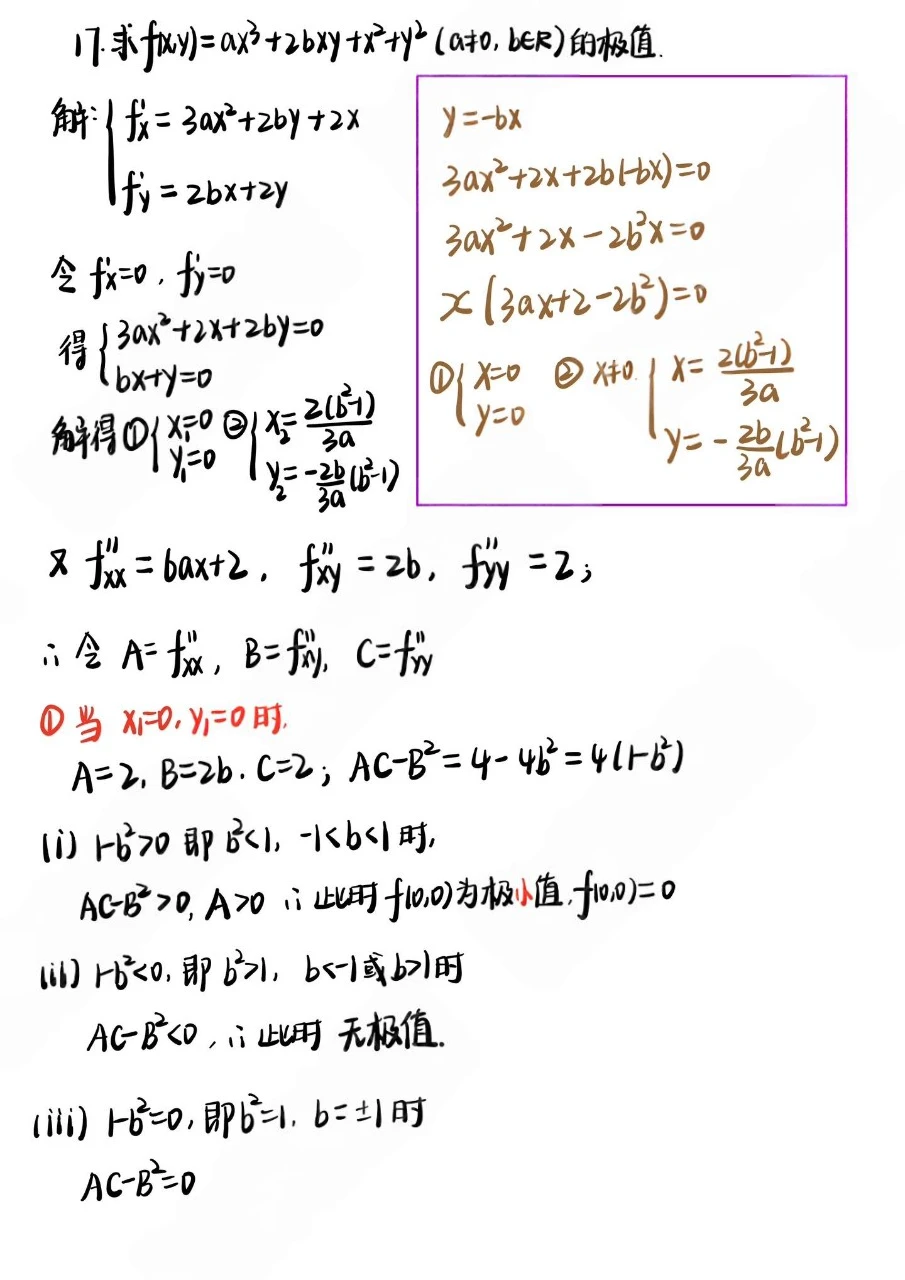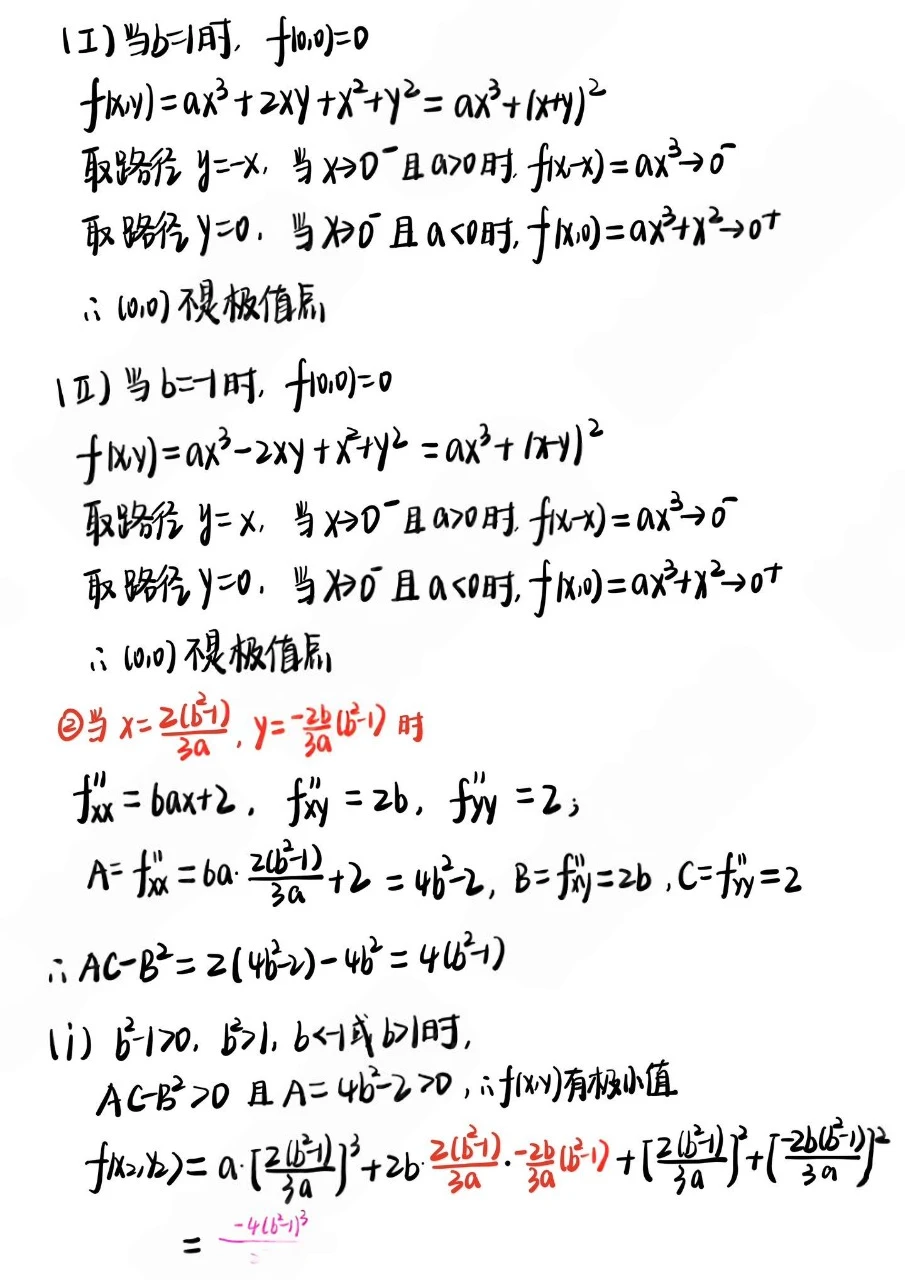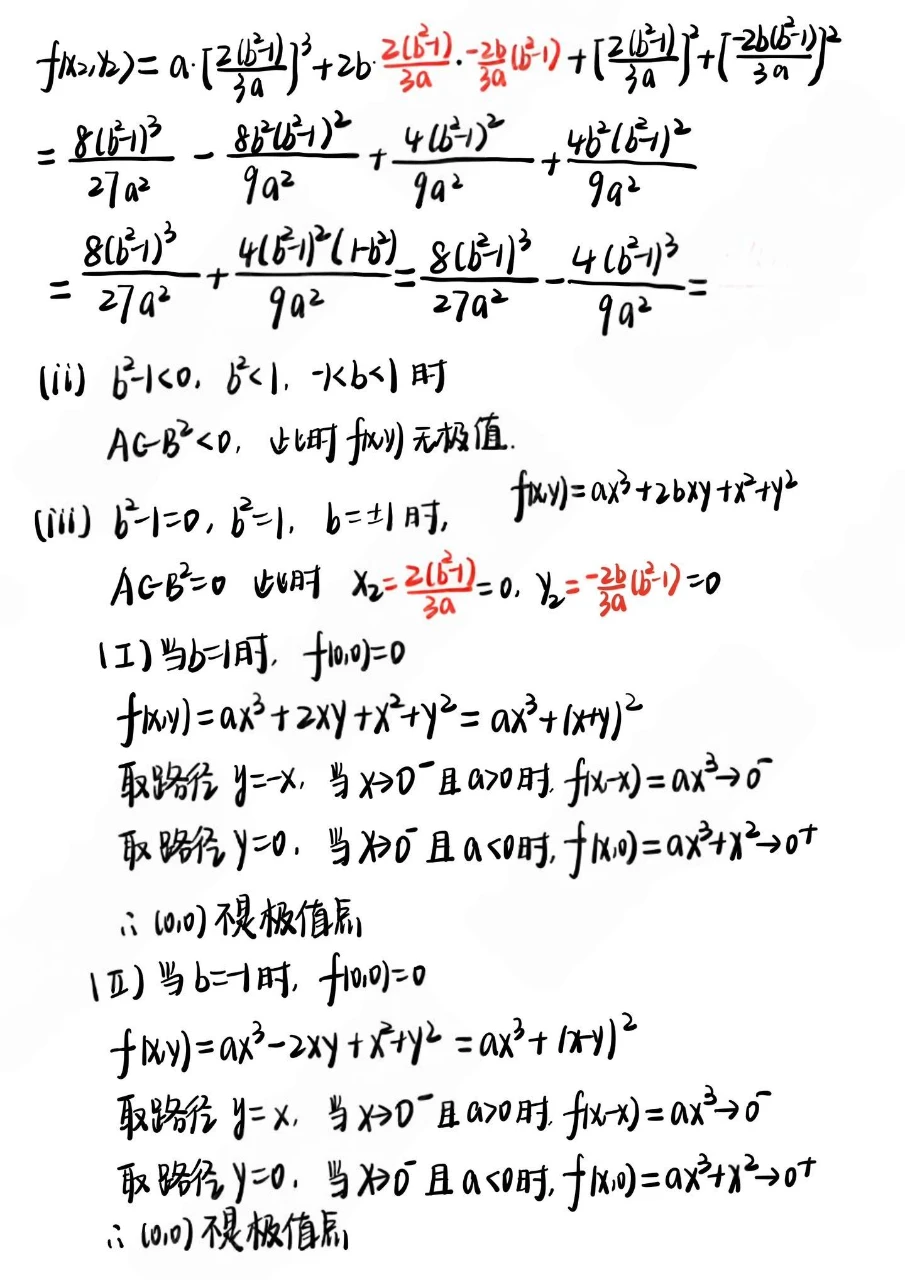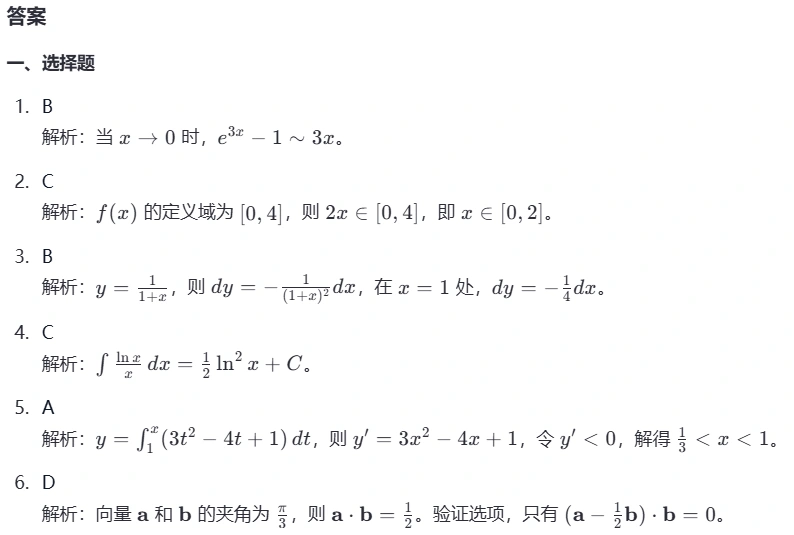
二、填空题
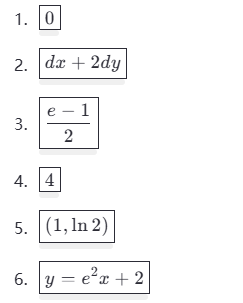
三、解答题
13.解答
1. 求常数 \( a \) 的值
为了使函数 \( f(x) \) 在 \( x = 0 \) 处连续,必须满足: \[ \lim_{x \to 0^-} f(x) = \lim_{x \to 0^+} f(x) = f(0). \] 当 \( x \geq 0 \): \[ f(x) = 2 \implies \lim_{x \to 0^+} f(x) = 2. \] 当 \( x < 0 \): \[ f(x) = \frac{x + e^{2ax} - 1}{x}. \] 计算左极限: \[ \lim_{x \to 0^-} f(x) = \lim_{x \to 0^-} \frac{x + e^{2ax} - 1}{x}. \] 这是一个 \(\frac{0}{0}\) 型不定式,使用洛必达法则: \[ \lim_{x \to 0^-} \frac{x + e^{2ax} - 1}{x} = \lim_{x \to 0^-} \frac{\frac{d}{dx}(x + e^{2ax} - 1)}{\frac{d}{dx}(x)}. \] 分子的导数为: \[ \frac{d}{dx}(x + e^{2ax} - 1) = 1 + 2a e^{2ax}. \] 分母的导数为: \[ \frac{d}{dx}(x) = 1. \] 因此: \[ \lim_{x \to 0^-} \frac{x + e^{2ax} - 1}{x} = \lim_{x \to 0^-} (1 + 2a e^{2ax}). \] 当 \( x \to 0^- \),\( e^{2ax} \to e^0 = 1 \),所以: \[ \lim_{x \to 0^-} (1 + 2a e^{2ax}) = 1 + 2a. \] 连续性条件: \[ \lim_{x \to 0^-} f(x) = \lim_{x \to 0^+} f(x) \implies 1 + 2a = 2. \] 解得: \[ 2a = 1 \implies a = \frac{1}{2}. \] 答案: \(\boxed{\frac{1}{2}}\)2. 计算极限 \(\lim_{x \to 0} \frac{x(1 - \cos x)}{x - \sin x}\)
需要计算: \[ \lim_{x \to 0} \frac{x(1 - \cos x)}{x - \sin x}. \] 这是一个 \(\frac{0}{0}\) 型不定式,使用洛必达法则。 分子: \[ x(1 - \cos x). \] 当 \( x \to 0 \),分子趋于 0。 分母: \[ x - \sin x. \] 当 \( x \to 0 \),分母也趋于 0。 应用洛必达法则: \[ \lim_{x \to 0} \frac{x(1 - \cos x)}{x - \sin x} = \lim_{x \to 0} \frac{\frac{d}{dx}[x(1 - \cos x)]}{\frac{d}{dx}[x - \sin x]}. \] 计算分子的导数: \[ \frac{d}{dx}[x(1 - \cos x)] = (1 - \cos x) + x \cdot \sin x. \] 计算分母的导数: \[ \frac{d}{dx}[x - \sin x] = 1 - \cos x. \] 因此: \[ \lim_{x \to 0} \frac{x(1 - \cos x)}{x - \sin x} = \lim_{x \to 0} \frac{(1 - \cos x) + x \sin x}{1 - \cos x}. \] 再次应用洛必达法则: \[ \lim_{x \to 0} \frac{(1 - \cos x) + x \sin x}{1 - \cos x} = \lim_{x \to 0} \frac{\frac{d}{dx}[(1 - \cos x) + x \sin x]}{\frac{d}{dx}[1 - \cos x]}. \] 计算分子的导数: \[ \frac{d}{dx}[(1 - \cos x) + x \sin x] = \sin x + (\sin x + x \cos x) = 2\sin x + x \cos x. \] 计算分母的导数: \[ \frac{d}{dx}[1 - \cos x] = \sin x. \] 因此: \[ \lim_{x \to 0} \frac{(1 - \cos x) + x \sin x}{1 - \cos x} = \lim_{x \to 0} \frac{2\sin x + x \cos x}{\sin x}. \] 化简: \[ \lim_{x \to 0} \frac{2\sin x + x \cos x}{\sin x} = \lim_{x \to 0} \left( \frac{2\sin x}{\sin x} + \frac{x \cos x}{\sin x} \right) = \lim_{x \to 0} \left( 2 + \frac{x \cos x}{\sin x} \right). \] 使用等价无穷小替换 \( \sin x \sim x \)(当 \( x \to 0 \)): \[ \frac{x \cos x}{\sin x} \sim \frac{x \cos x}{x} = \cos x. \] 因此: \[ \lim_{x \to 0} \left( 2 + \frac{x \cos x}{\sin x} \right) = 2 + \lim_{x \to 0} \cos x = 2 + 1 = 3. \] 答案: \(\boxed{3}\)14.解答
平面图形 \( D \) 的面积可以通过定积分计算: \[ \text{面积} = \int_{0}^{\frac{\pi}{2}} \sin x \, dx \] 计算结果为: \[ \int_{0}^{\frac{\pi}{2}} \sin x \, dx = \left[ -\cos x \right]_{0}^{\frac{\pi}{2}} = 1 \] 因此,平面图形 \( D \) 的面积为: \[ \boxed{1} \](2) 绕 \( x \)-轴旋转一周形成的旋转体的体积
使用圆盘法,旋转体的体积公式为: \[ V = \pi \int_{0}^{\frac{\pi}{2}} (\sin x)^2 \, dx \] 利用三角恒等式 \( \sin^2 x = \frac{1 - \cos(2x)}{2} \),化简为: \[ \int_{0}^{\frac{\pi}{2}} (\sin x)^2 \, dx = \frac{1}{2} \int_{0}^{\frac{\pi}{2}} 1 \, dx - \frac{1}{2} \int_{0}^{\frac{\pi}{2}} \cos(2x) \, dx \] 分别计算两个积分: \[ \int_{0}^{\frac{\pi}{2}} 1 \, dx = \frac{\pi}{2}, \quad \int_{0}^{\frac{\pi}{2}} \cos(2x) \, dx = 0 \] 所以: \[ \int_{0}^{\frac{\pi}{2}} (\sin x)^2 \, dx = \frac{\pi}{4} \] 最终旋转体的体积为: \[ V = \pi \cdot \frac{\pi}{4} = \frac{\pi^2}{4} \] 因此,旋转体的体积为: \[ \boxed{\frac{\pi^2}{4}} \]15.解答
已知直线 \( L \) 的参数方程为: \[ \begin{cases} x = 2 + 4t \\ y = -1 - t \\ z = -3 + 2t \end{cases} \] 由此可以看出,直线 \( L \) 的方向向量为: \[ \mathbf{d} = \langle 4, -1, 2 \rangle \] 要求的直线过点 \((-1, -4, 3)\),且与直线 \( L \) 平行,因此其方向向量也为 \(\mathbf{d} = \langle 4, -1, 2 \rangle\)。根据直线的参数方程形式,所求直线的方程为: \[ \begin{cases} x = -1 + 4t \\ y = -4 - t \\ z = 3 + 2t \end{cases} \] 因此,所求直线的方程为: \[ \boxed{\begin{cases} x = -1 + 4t \\ y = -4 - t \\ z = 3 + 2t \end{cases}} \]
(2) 求过点 \((2, 3, -1)\) 且与平面 \(\pi_1: 2x - y + 3z - 1 = 0\) 和平面 \(\pi_2: x + 2y + 2z + 1 = 0\) 都垂直的平面方程。
设所求平面的法向量为 \(\mathbf{n} = \langle A, B, C \rangle\)。由于所求平面与平面 \(\pi_1\) 和 \(\pi_2\) 都垂直,因此 \(\mathbf{n}\) 必须分别与 \(\pi_1\) 和 \(\pi_2\) 的法向量平行。 平面 \(\pi_1\) 的法向量为: \[ \mathbf{n}_1 = \langle 2, -1, 3 \rangle \] 平面 \(\pi_2\) 的法向量为: \[ \mathbf{n}_2 = \langle 1, 2, 2 \rangle \] 所求平面的法向量 \(\mathbf{n}\) 必须同时垂直于 \(\mathbf{n}_1\) 和 \(\mathbf{n}_2\),因此可以取 \(\mathbf{n}\) 为 \(\mathbf{n}_1\) 和 \(\mathbf{n}_2\) 的叉积: \[ \mathbf{n} = \mathbf{n}_1 \times \mathbf{n}_2 = \begin{vmatrix} \mathbf{i} & \mathbf{j} & \mathbf{k} \\ 2 & -1 & 3 \\ 1 & 2 & 2 \end{vmatrix} \] 计算叉积: \[ \mathbf{n} = \mathbf{i} \begin{vmatrix} -1 & 3 \\ 2 & 2 \end{vmatrix} - \mathbf{j} \begin{vmatrix} 2 & 3 \\ 1 & 2 \end{vmatrix} + \mathbf{k} \begin{vmatrix} 2 & -1 \\ 1 & 2 \end{vmatrix} \] \[ = \mathbf{i}((-1)(2) - (3)(2)) - \mathbf{j}((2)(2) - (3)(1)) + \mathbf{k}((2)(2) - (-1)(1)) \] \[ = \mathbf{i}(-2 - 6) - \mathbf{j}(4 - 3) + \mathbf{k}(4 + 1) \] \[ = \mathbf{i}(-8) - \mathbf{j}(1) + \mathbf{k}(5) \] \[ = \langle -8, -1, 5 \rangle \] 因此,所求平面的法向量为 \(\mathbf{n} = \langle -8, -1, 5 \rangle\)。平面过点 \((2, 3, -1)\),根据平面的点法式方程: \[ A(x - x_0) + B(y - y_0) + C(z - z_0) = 0 \] 其中 \((x_0, y_0, z_0) = (2, 3, -1)\),代入法向量 \(\mathbf{n} = \langle -8, -1, 5 \rangle\),得到: \[ -8(x - 2) - 1(y - 3) + 5(z + 1) = 0 \] 展开并整理: \[ -8x + 16 - y + 3 + 5z + 5 = 0 \] \[ -8x - y + 5z + 24 = 0 \] 因此,所求平面的方程为: \[ \boxed{-8x - y + 5z + 24 = 0} \]
16.解答
给定微分方程: \[ y' - 2x \cdot \frac{y^2 + 2y}{y - 2} = 0 \] 可以重写为: \[ y' = 2x \cdot \frac{y^2 + 2y}{y - 2} \] 这是一个可分离变量的微分方程。将变量分离: \[ \frac{dy}{dx} = 2x \cdot \frac{y^2 + 2y}{y - 2} \] 分离变量后得到: \[ \frac{y - 2}{y^2 + 2y} \, dy = 2x \, dx \] 接下来对两边积分。先处理左边的积分: \[ \int \frac{y - 2}{y^2 + 2y} \, dy \] 使用部分分式分解,设: \[ \frac{y - 2}{y^2 + 2y} = \frac{A}{y} + \frac{B}{y + 2} \] 通分后得: \[ \frac{y - 2}{y(y + 2)} = \frac{A(y + 2) + By}{y(y + 2)} \] 比较分子系数,得到: \[ y - 2 = A(y + 2) + By \] 展开并整理: \[ y - 2 = Ay + 2A + By = (A + B)y + 2A \] 比较系数: \[ \begin{cases} A + B = 1 \\ 2A = -2 \end{cases} \] 解得: \[ A = -1, \quad B = 2 \] 因此: \[ \frac{y - 2}{y^2 + 2y} = \frac{-1}{y} + \frac{2}{y + 2} \] 左边的积分变为: \[ \int \left( \frac{-1}{y} + \frac{2}{y + 2} \right) \, dy = -\ln|y| + 2\ln|y + 2| + C_1 \] 右边的积分: \[ \int 2x \, dx = x^2 + C_2 \] 将两边积分结果合并: \[ -\ln|y| + 2\ln|y + 2| = x^2 + C \] 其中 \( C = C_2 - C_1 \) 是常数。 利用对数性质化简: \[ \ln\left| \frac{(y + 2)^2}{y} \right| = x^2 + C \] 去掉对数: \[ \left| \frac{(y + 2)^2}{y} \right| = e^{x^2 + C} = e^C \cdot e^{x^2} \] 设 \( e^C = K \),则: \[ \frac{(y + 2)^2}{y} = Ke^{x^2} \] 应用初始条件 \( y(0) = 1 \): \[ \frac{(1 + 2)^2}{1} = K \cdot e^0 \implies \frac{9}{1} = K \implies K = 9 \] 因此,特解为: \[ \frac{(y + 2)^2}{y} = 9e^{x^2} \] 最终答案为: \[ \boxed{\frac{(y + 2)^2}{y} = 9e^{x^2}} \]
(2) 求微分方程 \( y'' + 5y' + 6y = 0 \) 满足初始条件 \( y(0) = 2 \) 和 \( y'(0) = -3 \) 的特解。
给定微分方程: \[ y'' + 5y' + 6y = 0 \] 这是一个二阶线性齐次微分方程。特征方程为: \[ r^2 + 5r + 6 = 0 \] 解特征方程: \[ r^2 + 5r + 6 = (r + 2)(r + 3) = 0 \] 特征根为: \[ r_1 = -2, \quad r_2 = -3 \] 因此,通解为: \[ y(x) = C_1 e^{-2x} + C_2 e^{-3x} \] 应用初始条件 \( y(0) = 2 \): \[ y(0) = C_1 e^0 + C_2 e^0 = C_1 + C_2 = 2 \] 即: \[ C_1 + C_2 = 2 \tag{1} \] 对通解求导: \[ y'(x) = -2C_1 e^{-2x} - 3C_2 e^{-3x} \] 应用初始条件 \( y'(0) = -3 \): \[ y'(0) = -2C_1 e^0 - 3C_2 e^0 = -2C_1 - 3C_2 = -3 \] 即: \[ -2C_1 - 3C_2 = -3 \tag{2} \] 联立方程 (1) 和 (2): \[ \begin{cases} C_1 + C_2 = 2 \\ -2C_1 - 3C_2 = -3 \end{cases} \] 解这个方程组。首先由 (1) 得: \[ C_1 = 2 - C_2 \] 代入 (2): \[ -2(2 - C_2) - 3C_2 = -3 \] 展开并整理: \[ -4 + 2C_2 - 3C_2 = -3 \implies -4 - C_2 = -3 \implies C_2 = -1 \] 代入 \( C_1 = 2 - C_2 \): \[ C_1 = 2 - (-1) = 3 \] 因此,特解为: \[ y(x) = 3e^{-2x} - e^{-3x} \] 最终答案为: \[ \boxed{y(x) = 3e^{-2x} - e^{-3x}} \]
17题.
